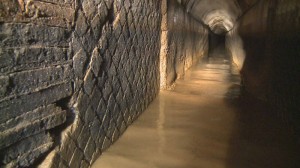How Roman Aqueducts Were Made
The aqueduct was a major component in the Roman water supply. From design to construction, how did these structures transport water across such great distances?
The Romans placed great importance on sanitation. From 800 BC onwards they established an efficient and complex system that sustained latrines, sewers and drainage systems. The Romans also built public lavatories where people would socialize, sitting on long benches interspersed with holes. The cities were equipped with fountains that supplied public drinking water. The Romans were also familiar with conservation, and recycled public bath water by flushing it through their latrines.
The water was supplied through a network of aqueducts, which acted as arteries throughout Rome; the city was equipped with 11 aqueducts constructed over a period of about 500 years. Aqueducts were also built in other Roman provinces, where they supplied estates, mines and mills.
 The management of Roman aqueducts was recorded by a man called Frontinus, who mapped and surveyed these ancient water systems. In the city of Rome, the combined length of the aqueducts is estimated at around 800km (500 miles|. As in the case of many aqueducts, only a small proportion – 47 kilometres (29 miles) – could be seen above ground. Most Roman aqueducts ran underground, helping to keep the water free from disease.
The management of Roman aqueducts was recorded by a man called Frontinus, who mapped and surveyed these ancient water systems. In the city of Rome, the combined length of the aqueducts is estimated at around 800km (500 miles|. As in the case of many aqueducts, only a small proportion – 47 kilometres (29 miles) – could be seen above ground. Most Roman aqueducts ran underground, helping to keep the water free from disease.
In addition to masonry aqueducts, the Romans built an extensive series of leats: these water channels, excavated in the ground, were designed with a lining of clay. This amazing system allowed the steady growth of the city state, and helped to maintain both a military and civilian population.
Design of an aqueduct
The first challenge that faced the Romans was the surveying of the land and the planning of the aqueduct. A site was chosen because of the availability of spring water. Most often, the Romans selected mountainous or high terrain and employed many different tools to build the aqueducts. The most important of these was the groma, a series of stones suspended from strings that was used to measure right angles. While the Romans used a water level known as a ‘chorobate’, they also measured vertical angles with a dioptra.
Once built, these aqueducts were impressive structures that were designed to defy time. The water flow depended on gravity, and was propelled by a gradient which prevented overflow. This volume of water subsequently passed through high and low ground. Here, flow was aided by pressurised pipelines known as ‘inverted siphons’ – these siphons were used to pump the water uphill. Before being piped to towns and cities, the water was stored in a holding tank.
![Aqua traiana aqueduct Aqua traiana aqueduct]() Famous Roman aqueducts
Famous Roman aqueducts
Aqua Marcia – The longest Roman aqueduct, it was founded in 144 BC. The source for the aqueduct was over 91km (57 miles) away in the Anio Valley.
Aqua Traiana – Dated June 109 AD, Traiana was designed to supply grain mills. During the 17th Century, it was reconstructed by the Vatican.
Aqua Appia – Dated 312 BC, it flowed mostly underground and was capable of delivering 73,000 cubic metres (2.6 million cubic feet) of water daily into Rome.


